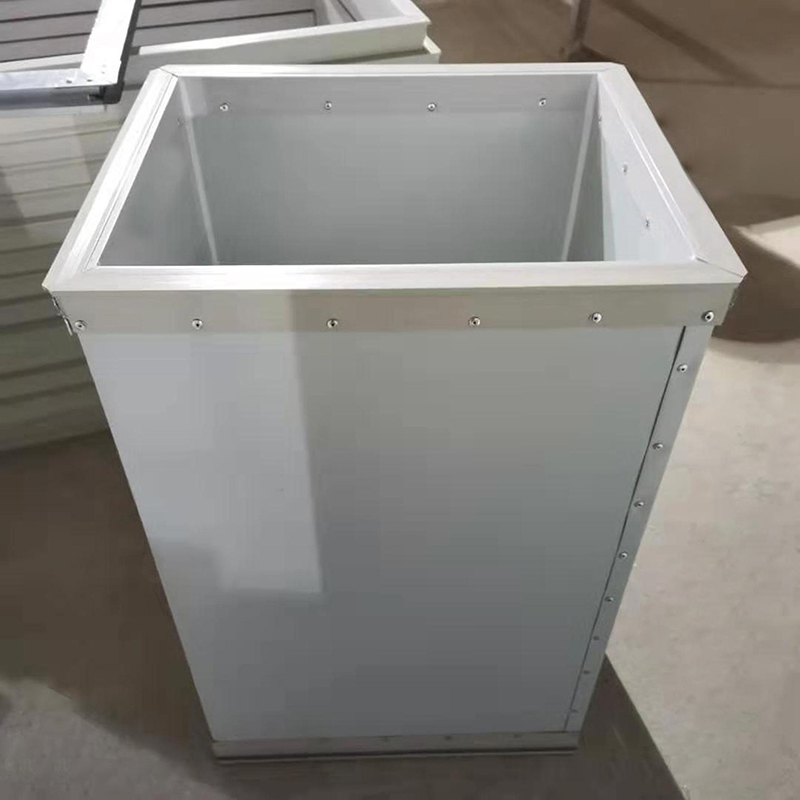In commercial, industrial, and large-scale residential HVAC systems, stack ductwork—vertical or angled ducts that vent exhaust air, supply conditioned air to multi-story spaces, or connect central units to upper floors—demands materials that balance strength, corrosion resistance, and airflow efficiency. Imperial galvanized steel stack ductwork stands out in this niche, leveraging the durability of galvanized steel with dimensions tailored to imperial measurements (inches, feet) for compatibility with North American HVAC infrastructure. But what makes this material superior to alternatives like aluminum, flexible ducting, or non-galvanized steel? How does its design optimize stack-specific challenges (e.g., vertical airflow, moisture exposure)? This guide explores its core benefits, material advantages, installation best practices, and industry applications.

Imperial galvanized steel stack ductwork is a specialized type of HVAC ducting engineered for vertical or steeply angled airflow applications (e.g., exhaust stacks for commercial kitchens, multi-story building supply ducts, industrial ventilation shafts). Its defining characteristics include:
1. Imperial Sizing: Manufactured to North American imperial standards (e.g., 6-inch diameter round ducts, 12x8-inch rectangular ducts) for seamless integration with existing imperial-sized HVAC components (fans, dampers, vents).
2. Galvanized Steel Construction: Cold-rolled steel coated with a hot-dipped zinc layer (typically 0.8–1.2 oz/sq ft zinc thickness). The zinc acts as a sacrificial anode, protecting the steel from rust and corrosion—critical for stack ductwork, which often operates in moisture-prone environments (e.g., building crawlspaces, rooftop exhausts).
3. Rigid, Structural Design: Unlike flexible ducting, it maintains its shape under vertical pressure (e.g., supporting its own weight in tall buildings) and resists deformation from airflow turbulence or external impacts.
This combination makes it ideal for stack applications where durability, airflow consistency, and long service life are non-negotiable.
Core Benefits of Imperial Galvanized Steel Stack Ductwork
Stack ductwork faces unique challenges—vertical airflow resistance, moisture accumulation, and structural stress—that galvanized steel addresses better than alternative materials:
1. Superior Corrosion Resistance for Moisture-Prone Stacks
Stacks often vent warm, humid air (e.g., commercial kitchen exhaust, bathroom ventilation) or operate in unconditioned spaces (rooftops, basements) where moisture condenses on duct surfaces. The zinc coating on galvanized steel:
- Prevents rust formation even with repeated moisture exposure (service life of 20–30 years, vs. 5–10 years for non-galvanized steel).
- Eliminates the need for frequent repainting or coating (a common maintenance task for non-galvanized stack ducts).
For example, a rooftop exhaust stack made of imperial galvanized steel will resist rain, snow, and condensation-induced corrosion—unlike aluminum ducts, which may develop pitting in salty coastal environments.
2. Structural Strength for Vertical Installations
Vertical stack ducts must support their own weight (and sometimes insulation) over multiple floors (e.g., 10-story office buildings). Galvanized steel’s high tensile strength (30–50 ksi) and rigidity:
- Eliminates sagging or deformation, which would restrict airflow in flexible or lightweight aluminum ducts.
- Withstands external impacts (e.g., maintenance workers, rooftop equipment) without damage—critical for industrial or commercial settings.
A 12-inch diameter imperial galvanized steel stack can span 20+ feet between supports, vs. 8–10 feet for aluminum ducts (which require more frequent bracing).
3. Optimized Airflow Efficiency for Stacks
Stack ductwork relies on consistent airflow to overcome gravity (for supply stacks) or expel exhaust (for exhaust stacks). Galvanized steel’s advantages here include:
- Smooth Interior Surface: The zinc coating creates a low-friction interior, reducing airflow resistance (pressure drop) by 10–15% compared to rough-surfaced materials like fiberglass duct board.
- Precise Sizing: Imperial galvanized ducts are manufactured to tight tolerances (±0.01 inches), ensuring uniform diameter/width—critical for maintaining airflow velocity in vertical runs (too narrow, and airflow slows; too wide, and energy is wasted).
For a multi-story apartment building’s supply stack, this efficiency translates to consistent heating/cooling across all floors—no "cold bottom floors" or "hot top floors" common with poorly sized or flexible ducts.
4. Cost-Effectiveness Over Lifespan
While imperial galvanized steel has a higher upfront cost than flexible ducting or non-galvanized steel, its long service life and low maintenance needs deliver lower total cost of ownership (TCO):
- Reduced Replacement Costs: Lasts 2–3x longer than aluminum or flexible ducts, delaying replacement expenses by 15–20 years.
- Minimal Maintenance: No need for rust removal, repainting, or frequent repairs—annual inspections (vs. quarterly for aluminum) suffice.
For a commercial facility, the TCO of an imperial galvanized steel stack is 30–40% lower than aluminum over 20 years.
How Imperial Galvanized Steel Compares to Alternative Stack Duct Materials
To understand its value, compare it to common stack duct materials:
| Material | Key Advantage for Stacks | Key Disadvantage for Stacks |
|------------------------|---------------------------------------------------|---------------------------------------------------|
| Imperial Galvanized Steel | Corrosion resistance, structural strength, long lifespan | Higher upfront cost; heavier (requires more robust supports) |
| Aluminum | Lightweight (easier to install); good for coastal areas | Low strength (sags in long vertical runs); prone to pitting in industrial environments |
| Flexible Ducting | Low upfront cost; easy to route in tight spaces | Poor airflow (kinks restrict vertical airflow); degrades quickly in moisture |
| Non-Galvanized Steel | Low upfront cost; high strength | Rapid corrosion in stacks (requires frequent repainting); short lifespan |
Installation Best Practices for Imperial Galvanized Steel Stack Ductwork
Proper installation is critical to maximizing its performance—especially for vertical stacks:
1. Plan for Vertical Airflow and Support
- Support Spacing: Follow imperial standards (e.g., 10–15 feet for round ducts, 8–12 feet for rectangular ducts) to prevent sagging. Use galvanized steel hangers (not plastic) for compatibility and strength.
- Slope for Drainage: For exhaust stacks (e.g., kitchen, bathroom), angle the duct slightly (1/4 inch per foot) toward the outdoor vent to drain condensation—preventing water buildup inside the stack.
2. Ensure Airtight Connections
- Seal Joints: Use galvanized steel screws (to avoid corrosion) and mastic sealant (not duct tape, which degrades) to seal all joints. For high-pressure stacks (e.g., industrial exhaust), add a gasket between flanged connections.
- Minimize Leaks: Even small leaks (1–2% of duct area) can reduce stack efficiency by 10–15%. Test connections with a smoke pencil or pressure gauge after installation.
3. Insulate for Energy Efficiency and Condensation Control
- Insulate Unconditioned Runs: Wrap stack ducts in the attic, rooftop, or basement with fiberglass or foam insulation (R-value ≥6) to prevent heat gain/loss and condensation.
- Use Vapor Barriers: For humid exhaust stacks, add a vapor barrier to insulation to prevent moisture from seeping into the duct and causing corrosion.
Maintenance Tips to Extend Lifespan
1. Annual Inspections: Check for:
- Corrosion (pay special attention to joints and bottom of vertical stacks, where condensation collects).
- Loose supports or hangers (tighten or replace as needed).
- Blockages (e.g., lint in kitchen exhaust stacks, debris in rooftop vents)—clean with a duct brush or compressed air.
2. Clean Exhaust Stacks: For commercial kitchen or industrial exhaust stacks, have ducts professionally cleaned every 6–12 months to remove grease or debris (which can cause fires or airflow blockages).
3. Touch-Up Zinc Coating: If small scratches or chips occur (e.g., during maintenance), apply zinc-rich paint to prevent rust from spreading.
Ideal Applications for Imperial Galvanized Steel Stack Ductwork
This ductwork excels in scenarios where vertical airflow, durability, and corrosion resistance are critical:
- Commercial Buildings: Multi-story office, hotel, or apartment supply/exhaust stacks.
- Industrial Facilities: Exhaust stacks for factories, warehouses, or manufacturing plants (resists chemical fumes and moisture).
- Commercial Kitchens: Grease exhaust stacks (zinc coating resists grease-induced corrosion; smooth surface is easy to clean).
- Residential (Large): Rooftop exhaust stacks for multi-family homes or large single-family homes with vertical duct runs.






